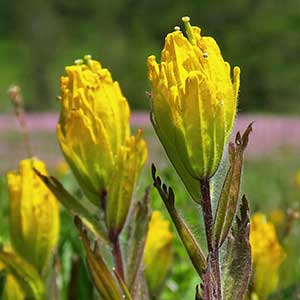Castilleja levisecta
Castilleja minor
golden Indian paintbrush, golden paintbrush
annual paintbrush, California threadtorch, lesser Indian paintbrush, little paintbrush, seep paintbrush, thread-torch paintbrush
few to many, erect, ± decumbent or creeping at base, unbranched, sometimes branched, hairs spreading, medium length and long, soft, mixed with short stipitate-glandular ones.
solitary or few, erect, unbranched, rarely branched distally, hairs sparse to dense, spreading, sometimes shaggy (var. minor), short to long, soft to stiff, eglandular and/or sparsely to densely stipitate-glandular.
green to purple or brown-tinged, linear-lanceolate proximally, oblong-ovate or -obovate distally, 0.8–5.2 cm, not fleshy, margins plane, distalmost sometimes ± wavy, involute, 3–7(–11)-lobed, apex obtuse;
lobes erect to ascending, linear to linear-spatulate, very short, toothlike, usually arising from distal 1/3 of blade, apex rounded.
green or purple to ± gray, linear to lanceolate, 2–10 cm, not fleshy, margins plane, sometimes wavy, ± involute, 0-lobed, apex acuminate to acute, sometimes obtuse.
2.5–25 × 1–4 cm;
bracts bright yellow throughout, or proximally greenish, distally bright yellow, sometimes deep yellow-orange, especially with age, oblong, elliptic, or obtuse to ovate, (0–)5–9(–13)-lobed, sometimes wavy-margined;
lobes erect to ascending, oblong, short to medium length, arising above mid length, central lobe apex rounded, lateral ones rounded to acute.
5–40 × 1–4 cm;
bracts proximally greenish, distally red, red-orange, or pale orange, rarely yellow, on apices, narrowly lanceolate, sometimes narrowly oblong to spatulate distally, 0-lobed, plane-margined, apex acuminate (oblong to narrowly spatulate in var. spiralis).
straight or slightly curved, 17–28 mm;
tube 12–15 mm;
beak exserted, adaxially green or greenish yellow, 6–8 mm;
abaxial lip yellow or greenish, reduced, not inflated, 2–3 mm, 25–33(–50)% as long as beak;
teeth ascending to erect, yellow, 0.5–1.5 mm.
straight, 13–39 mm;
tube 11–16(–20) mm;
beak partially to completely exserted, sometimes included, adaxially yellow, pale orange to red-orange, reddish brown, green, or white, 5–15(–20) mm;
abaxial lip yellow, white, red, deep red, red-violet, or green, colored as or strongly contrasting with rest of corolla, small but jutting out at 90° from axis of corolla, often readily visible through abaxial cleft, 1–3 mm, 5–25% as long as beak;
teeth spreading to strongly incurved, green, white, yellow, red, or red-purple, 0.2–1 mm.
distally yellow, 13–22 mm;
abaxial and adaxial clefts 4–9.5 mm, 30–40% of calyx length, deeper than laterals, lateral 2.5–4.5 mm, ca. 25% of calyx length;
lobes linear to narrowly oblong or narrowly lanceolate, apex obtuse, sometimes rounded to acute.
green or yellowish green, 13–27(–28) mm;
abaxial and adaxial clefts 6–15 mm, 33–75% of calyx length, deeper than laterals, lateral 0.5–4 mm, 5–20% of calyx length;
lobes linear to narrowly triangular or narrowly lanceolate, apex acute or acuminate.
= 24.
= 24.
Castilleja levisecta
Castilleja minor
Castilleja levisecta is listed as threatened in the United States and endangered in Canada, where it is extremely rare. Most of its grassland habitat has been altered by development in the Puget Trough, and there are historical stations in the metro areas of what are now Victoria, Portland, and Seattle. For several decades, C. levisecta was considered extirpated from Oregon. However, recent reintroduction programs in Oregon and Washington have been very successful at reestablishing this species at several sites in the Willamette Valley. The bright yellow inflorescences often gradually age to a golden yellow color, unique in the genus.
Castilleja levisecta is in the Center for Plant Conservation’s National Collection of Endangered Plants.
(Discussion copyrighted by Flora of North America; reprinted with permission.)
Varieties 4 (4 in the flora).
Castilleja minor is a widespread specialist of seeps, saline shores, and wet ground at moderate elevations. California has many populations on serpentine substrates. Most of the varieties have distinct ranges with little overlap, with the exception of the edaphic obligate var. spiralis, which is restricted to serpentine substrates.
(Discussion copyrighted by Flora of North America; reprinted with permission.)
1. Corolla beaks 5–8(–10) mm, usually 1/3 or less of length of corollas, included to more often partially exserted from calyces. | → 2 |
2. Abaxial lips of corollas red to reddish purple; leaves linear or linear-lanceolate, soft; mountains of c, e Arizona and adjacent New Mexico southward. | var. minor |
2. Abaxial lips of corollas whitish, pale green, or pale yellowish; leaves linear-lanceolate to lanceolate, coarse; widespread in Great Basin region. | var. exilis |
1. Corolla beaks 8–15(–20) mm, usually 1/3+ of length of corollas, exserted from calyces. | → 3 |
3. Proximal bracts narrowly lanceolate or oblanceolate, distals oblong to narrowly spatulate, apices rounded or obtuse, rarely acute; abaxial lips of corollas red. | var. spiralis |
3. Bracts linear to narrowly lanceolate, apices acuminate; abaxial lips of corollas whitish, rarely greenish or pale yellow (sometimes red in c Arizona). | var. stenantha |
- Local floras:
BC,
CA,
OR,
WA
- Local Web sites:
CalFlora,
CalPhotos,
Flora NW,
PNW Herbaria
WildflowerSearch
iNaturalist (observations)
USDA Plants Database
- LBJ Wildflower Center
- SEINet
- Plants of the World Online
- Encyclopedia of Life
- Wikipedia
- Google Image Search


